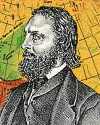
On 20 Aug 1831, the Austrian geologist Eduard Suess was born. He helped establish the fields of paleogeography and tectonics. He coined the name Gondwanaland for an ancient supercontinent that he proposed existed eons ago, but due to tectonic activity, broke apart into the continents we know today.
By reading an obituary of a scientist, often interesting sidelights are revealed. Such is the case with The Sketch of the Life of Eduard Suess by Pierre Termier, translated in the Annual Report of the Smithsonian Institution.
“Suess's water” was the way residents of Vienna referred to the new, purer water supply for which Suess spent three years convincing the municipal council of the need to switch from the unwholesome water of the Danube and lakes. Instead, he advised, there were mountain springs which would provide a greater purity and freshness. Seven years later, when this healthier water was brought to flow in the city, the obituary writer records that mortality in the city was halved. This geologist saved lives!

On 20 Aug 1953, the Soviet Union released the news that it had detonated its first hydrogen bomb, eight days earlier (12 Aug 1953), in Kazakhstan. It came less than 10 months after the first U.S. bomb test, Mike, (1 Nov 1952) announced by President Harry Truman on 7 Jan 1953. Notably, the Soviet bomb was more portable than the U.S. device—small enough to fit in a plane, and be easily weaponizeable, though its size limited the amount of thermonuclear fuel and explosive force. The Arms Race kicked into high gear.
Today's book pick is: Dark Sun: The Making of the Hydrogen Bomb, by Richard Rhodes, who earlier won the Pulitzer Prize for his book The Making of the Atomic Bomb. In Dark Sun, another monumental work of history, Rhodes provides the definitive, often shocking story of the politics and the science behind the development of the hydrogen bomb and the birth of the Cold War. Based on secret files in the United States and the former Soviet Union, this engrossing book discloses how and why the United States decided to create the bomb that would dominate world politics for more than forty years. Rhodes targets a general audience and with great success, balances the consequent need for clarity with depth and technical detail.
Whereas his earlier book on the atomic bomb told the story of scientists and the cooperation between nations to defeat the Nazis, Dark Sun tells the story of how weapons of mass destruction polarized scientists, nations, military sects, and political mindsets. It has over 120 five-star reviews on the Amazon site.
It is available from Amazon, typically about New from $10.49. Used from $2.01. (As of earlier time of writing - subject to change.)
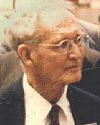 | The first business of a man of science is to proclaim the truth as he finds it, and let the world adjust itself as best it can to the new knowledge. |
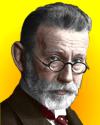 | Success in research needs four Gs: Glück, Geduld, Geschick und Geld. Luck, patience, skill and money. |
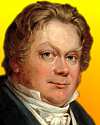 | Die Gewohnheit einer Meinung erzeugt oft völlige Ueberzeugung von ihrer Richtigkeit, sie verbirgt die schwächeren Theile davon, und macht uns unfähig, die Beweise dagegen anzunehmen. The habit of an opinion often leads to the complete conviction of its truth, it hides the weaker parts of it, and makes us incapable of accepting the proofs against it. |
| Before you look at today's web page, see if you can answer some of these questions about the events that happened on this day. Some of the names are very familiar. Others will likely stump you. Tickle your curiosity with these questions, then check your answers on today's web page. | |
| Births | |
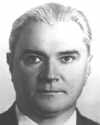 | Valentin Petrovich Glushko, born 20 Aug 1908 was a Soviet rocket scientist, a pioneer in rocket propulsion systems, and a major contributor to Soviet space and defense technology. He worked with renowned rocket designer Sergey Korolyov from 1932 to 1966. The two had a triumphant year in 1957, when they launched the first intercontinental ballistic missile in August and sent the first artificial satellite into orbit in October. What was the name of this satellite? |
 | Akutsu Tetsuzo (left), Eduard Suess and Jöns Jacob Berzelius were each born on 20 Aug, though in different years. Not in the same order, they were notable for postulating the existence of the giant landmass Gondwanaland; building the first artificial heart that was implanted and kept an animal alive; and the development of modern chemical symbols (such as Fe). Can you match each scientist to his claim to fame? |
| Deaths | |
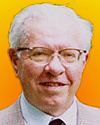 | Sir Fred Hoyle (1915-2001) unintentionally coined the term “Big Bang.” Can you describe the theory of the universe he believed in? |
 | Percy Williams Bridgman (1882-1961) was an American experimental physicist noted for his studies of materials at high temperatures and pressures. He was awarded the Nobel Prize for Physics in 1946 for his “invention of an apparatus to produce extremely high pressures.” To the nearest power of ten, how many atmospheres of pressure was he eventually able to produce? |
| Events | |
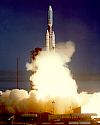 | On 20 Aug 1977, NASA launched Voyager 2, an unmanned spacecraft towards Jupiter, Saturn, Uranus and Neptune. It carried a 12-inch copper phonograph record. What did the recording contain? |
 | On 20 Aug of a certain year, the first demonstration telecast of home television in the U.S. was received in New York City. A half-hour program was hosted by the cartoonist Harry Hirschfeld, and demonstrated on screens placed in a store in the Hotel Ansonia, the Hearst building, and a home at 98 Riverside Drive. The signal travelled about six miles, the greatest distance for TV transmission to date. In which decade did this TV demonstration take place? |
Fast answers for the previous newsletter for August 19: Philco • Greenwich Observatory • James Watt • all of them • two dogs • daguerreotype.
 If you enjoy this newsletter, the website, or wish to offer encouragement or ideas, please send feedback by using your mail reader Reply button.
If you enjoy this newsletter, the website, or wish to offer encouragement or ideas, please send feedback by using your mail reader Reply button. Your click on a Facebook, StumbleUpon, or other social button on the site webpages is also a welcome sign of appreciation. Thank you for using them.
© This newsletter is copyright 2020 by todayinsci.com. Please respect the Webmaster's wishes and do not put copies online of the Newsletter — or any Today in Science History webpage. (If you already have done so, please remove them. Thank you.) Offline use in education is encouraged such as a printout on a bulletin board, or projected for classroom viewing. Online, descriptive links to our pages are welcomed, as these will provide a reader with the most recent revisions, additions and/or corrections of a webpage. For any other copyright questions, please contact the Webmaster by using your mail reader Reply button.
--
If you do not want to receive any more newsletters, Unsubscribe
To update your preferences and to unsubscribe visit this link
Executive Real Estate Business Class
-
"It was like a man with wings. It wasn't like anything you'd see on TV or in a monster movie." ...
About the publisher
Search This Blog
Blog Archive
-
▼
2020
(1542)
-
▼
August
(192)
- HISTORY: Lessons from the latest March on Washington
- New This Week on History News Network
- Discover lost cities with Nat Geo History. Subscri...
- On This Day for August 31 - Confederates evacuated...
- Newsletter for Monday 31 August.
- Face Masks Make you dumb (compliant) Economic des...
- August 31: Malaya Gains independence, Princess Dia...
- FAMILY: How to get your kid to wear a mask
- Roman numerals | Ancient empires | The battle of C...
- On This Day for August 30 - Historic spaceflight b...
- Newsletter for Sunday 30 August.
- August 30: Crossbow Outlawed, Nehru Requests Indep...
- The Compass: London
- On This Day for August 29 - New Orleans hit by Hur...
- Newsletter for Saturday 29 August.
- August 29: Treaty of Nanking, Second Battle of Bul...
- CORONAVIRUS UPDATE: These promising treatments are...
- PHOTOGRAPHY: Lives that matter, from the pietà to ...
- The Horrifying True Story Behind "Candyman," The Y...
- The Roundup Top Ten from History News Network
- On This Day for August 28 - Civil rights march on ...
- Newsletter for Friday 28 August.
- August 28: Tom Thumb Races a Horse, Scientific Ame...
- ANIMALS: When baby wombats become your roommates
- Give your kids the world! Subscribe now.
- Create remote resiliency with Britannica Kids
- On This Day for August 27 - The death of Titian, M...
- Newsletter for Thursday 27 August.
- Lockdown for you but not for the politically corre...
- August 27: Krakatoa Erupts and the End of Lord Mou...
- YOUR WEEKLY ESCAPE: Inside the world of transhuman...
- SCIENCE: Behind the hurricanes, wildfires, and bla...
- Demystified: What Does Gaslighting Mean?
- The Latest News from History News Network
- On This Day for August 26 - Joan of Arc's arrival ...
- Newsletter for Wednesday 26 August.
- Fear fatigue is more dangerous than COVID-19 plus
- August 26: Longbows, Cannons and Morris Mini-Minors
- For Your Eyes Only: America’s Spying Secrets
- 50+ Vintage Pictures Of Your Parents Being Cooler ...
- TRAVEL: Waiting for a silver lining
- On This Day for August 25 - Paris liberated, Sean ...
- Newsletter for Tuesday 25 August.
- August 25: French Arrive in Louisiana, James Cook ...
- HISTORY: Why the U.S. Postal Service matters
- Even Life-Long Learners Need Back-to-School Savings!
- Experience a 360-degree virtual tour of the Nat Ge...
- New This Week From History News Network
- On This Day for August 24 - Eruption of Mount Vesu...
- Newsletter for Monday 24 August.
- GeoEngineering Massive Drought WildFires + More Ma...
- August 24: Alaric I Sacks Rome, British Capture Wa...
- FAMILY: How you can support your kid's teachers—an...
- Genghis Khan | Edward the Confessor | The Spanish ...
- On This Day for August 23 - William Wallace execut...
- Newsletter for Sunday 23 August.
- August 23: 1st US Women's Rights Convention, Bin L...
- The Compass: U.S. National Parks
- On This Day for August 22 - Wars of the Roses ende...
- Newsletter for Saturday 22 August.
- August 22: Wars of the Roses Ends, Chennai Founded...
- CORONAVIRUS UPDATE: Your employer could require yo...
- PHOTOGRAPHY: Capturing a muted Russia
- The Unsung Heroes Who Fought For Women's Voting Ri...
- The Roundup Top Ten from History News Network
- On This Day for August 21 - French defeated at the...
- Newsletter for Friday 21 August.
- YOUR WEEKLY ESCAPE: A million people live in under...
- August 21: Mona Lisa is Stolen, the 50th US State ...
- ANIMALS: Soft and virus-y, the mink with COVID-19
- On This Day for August 20 - Viking 1 launched, Eer...
- Total Exposé! Watch the 2nd Plandemic Movie "InDoc...
- Newsletter for Thursday 20 August.
- August 20: The Dutch East India Company, Sun Yat-s...
- A Champion Will Be Crowned on 'Forged in Fire' Ton...
- SCIENCE: The robots have arrived
- The Latest News from History News Network
- On This Day for August 19 - Attempted coup against...
- Newsletter for Wednesday 19 August.
- August 19: Cease-Fire in the Iran-Iraq War and Gor...
- TRAVEL: Will new tech make flying safer now?
- Sail along with Ancient Explorers w/ Nat Geo History!
- On This Day for August 18 - Nineteenth Amendment r...
- Newsletter for Tuesday 18 August.
- August 18: Wilson's Ill-fated Neutrality, American...
- HISTORY: Breaking 'substantial barriers' with Kama...
- New This Week On History News Network
- On This Day for August 17 - Indonesia's declaratio...
- Newsletter for Monday 17 August.
- State of Tennessee orders Home visit checks on ALL...
- August 17: Division of Korea, Indonesian Independe...
- FAMILY: Preparing for this unusual school year
- Medieval baby names | Attila the Hun | Pederasty i...
- On This Day for August 16 - Leonel Fernández Reyna...
- Newsletter for Sunday 16 August.
- August 16: Deadly Chaos in Calcutta and the Last C...
- The Compass: New Zealand
- On This Day for August 15 - Independence for India...
- Newsletter for Saturday 15 August.
- August 15: The Mayflower Sets Sail, Indian Indepen...
-
▼
August
(192)
-
Blogroll
-
About
HistoryFact










0 comments:
Post a Comment